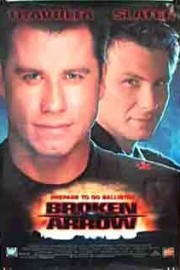Broken Arrow
“Broken Arrow” was the first John Woo film I’d ever seen. Of course, it’s not a John Woo film in the same way “The Killer” or “Hard-Boiled” or “Bullet in the Head” are, although it does have common Woo themes like friendship and betrayal, to say nothing of a lot of slow-motion gun fighting. But before 1997’s “Face/Off,” he hadn’t yet been able to adapt his signature style to a Hollywood film, so really, it was take what you can get. For a lot of people, that wasn’t good enough, but I’ve always enjoyed the film, and not just for Woo’s work.
This was the first film I’d seen where I had consciously paid attention to Hans Zimmer. Yes, there were films he had worked on I had watched, like “Crimson Tide,” which was a hugely influential action score for the composer (although he had already redefined the action genre musically with “Black Rain” and “Backdraft”), but I wasn’t as immersed in film music and film composers as I would be in 1996, so Zimmer (whose Oscar-winning work in “The Lion King” I hadn’t heard yet) didn’t make his presence felt for me until “Arrow.” In the long run, it’s hardly his best work, but it had a huge effect on me. It was the first time I really paid attention to an electronic soundtrack, and electronic music. When I got the soundtrack album, it was fascinating to not only read the liner notes about the composer and director, but also to see that there were eight credited musicians who worked on the recording of the score. I had already decided composing was something I wanted to do, but Zimmer and “Broken Arrow” opened up an entirely new door for me I’m still walking through 18 years later with my music, even if it’s not exactly the same as what Zimmer does.
Back to the film, though. “Broken Arrow” may be a John Woo film in name (and sometimes, theme), but it’s also a product of producer Mark Gordon and screenwriter Graham Yost, two of the men responsible for “Speed.” On the surface, that 1994 hit and “Broken Arrow” don’t have much in common save for bombs, a diabolical villain, a square-jawed hero, and a plucky heroine, but underneath, it’s easy to see them being the product of the same filmmakers. What distinguishes this from “Speed” is not just what Woo brings to the table stylistically, and what the actors bring in terms of personality. As Major Deakins, a 20-year Air Force pilot who is stealing two nuclear weapons, John Travolta is delightfully full of himself and wickedly fun, tweaking the persona he built up in “Pulp Fiction” and “Get Shorty” in ways that hinted at his even-better bad guy work the next year in Woo’s “Face/Off.” Sparring off with him as Christian Slater as Captain Hale, a long-time friend of Deakins’s and co-pilot who survives the crash Deakins stages with a B-3 stealth bomber they are taking on a test run– the bomber is what has the nuclear payload. Along for the ride is Samantha Mathis as a park ranger who gets caught in the middle of this cat-and-mouse game, much like Sandra Bullock’s character in “Speed” did. With that basic description, you can pretty much figure things out from there, I’m sure.
The film lacks the energy and intelligence of not just “Speed” but Woo’s far-superior follow-up, “Face/Off,” but that doesn’t mean “Broken Arrow” lacks fun comparable to either of those movies. Slater and Travolta have an easy chemistry with one another, and Mathis does a good job with a razor-thin character. There are some other solid performances (for an action movie, that is) along the way, including Howie Long with one of Deakins’s lackeys; Bob Gunton as the money behind the operation; Delroy Lindo as an Air Force Colonel on the case; and Frank Whaley as a Washington egghead who is good with intelligence, but this isn’t about acting but action, and “Broken Arrow” has some fine action sequences. The best sequence in the film involves a shootout in an abandoned mine that is capped by an underground nuclear blast which Woo and his collaborators (including cinematographer Peter Levy, editors Joe Hutshing, Steve Mirkovich, and John Wright, and Zimmer) ring maximum thrills out of, while the blast is a great piece of visual effects magic from Woo, who had little experience with such effects prior to this film. “Broken Arrow” is hardly a classic for the genre, but that’s not the point– it was a stepping stone, and after his 1993 American debut, “Hard Target,” it was definitely a step in the right direction for Woo, who was allowed more freedom with not just “Face/Off” but his later efforts, “M:i-2” and “Windtalkers,” although after 2003’s “Paycheck,” he was done with Hollywood and returned to Asia to continue making movies. So far, that’s only including the historical epic “Red Cliff,” but I’m hoping he’s not quite done, because after “Broken Arrow” (regardless of whether it’s top-flight filmmaking or not), I became a Woo fan for life. For that reason, I’ll always be thankful for this minor entry in his considerable filmmography.










